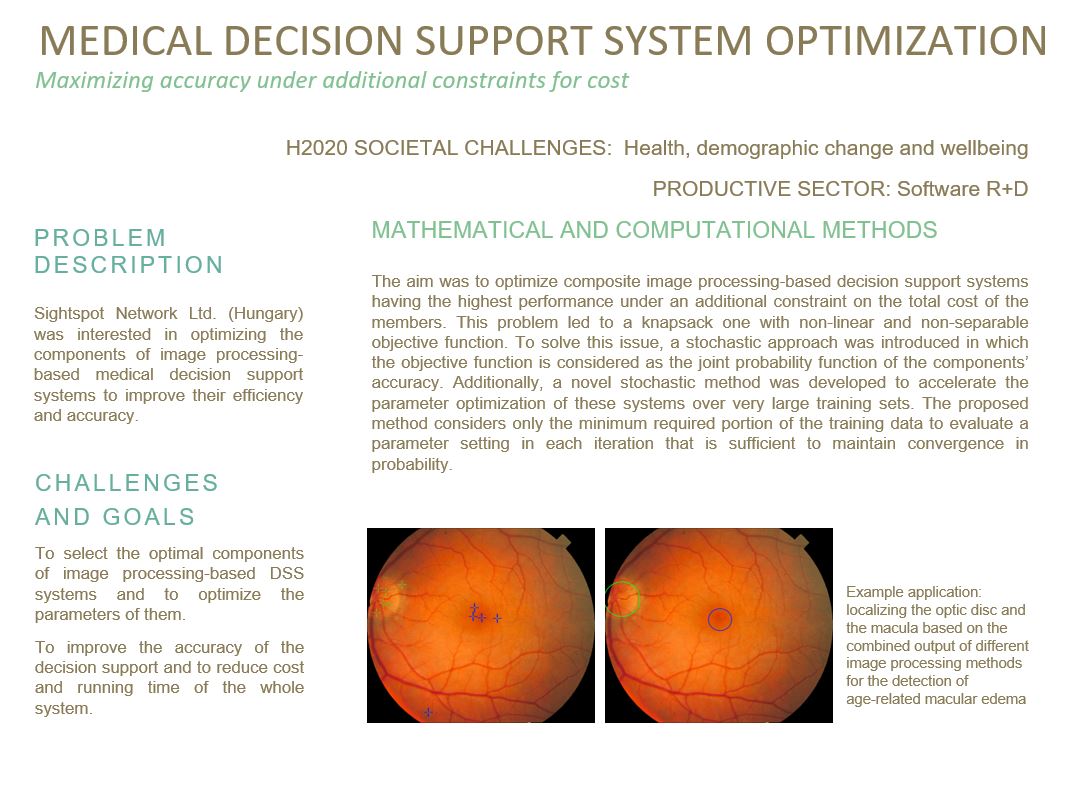 Kutatás vezetője: Dr. Hajdu András
Kutatás vezetője: Dr. Hajdu András
Intézmény: University of Debrecen
Leírás: A mini-projekt során sikeresen vizsgáltuk, miként lehet sztochasztikus módszerek segítségével hatékony fúziós rendszereket összeállítani azok komponenseinek költségét is figyelembe véve, valamint kidolgoztunk egy módszert, amely fúziós rendszerek paraméter-optimalizálását gyorsítja nagyméretű tanulóhalmazok felett. A mini-projekt során vizsgáltuk továbbá a mély konvolúciós neurális hálók fúziós rendszerbe történő szervezésének, valamint a mélytanuló és a hagyományos képfeldolgozó módszerek által kinyert jellemzők kombinálásának lehetőségeit is.
During the reported period, we investigated how to build efficient ensembles using stochastic methods and how to organize deep convolutional neural networks into fusion-based systems.
One of our research aims was to examine creating and characterizing ensembles having the highest performance (e.g., in terms of accuracy) under an additional constraint on the total cost of the members. This problem leads to a knapsack one with non-linear and non-separable objective function in both binary and multiclass classification. To solve this issue, we introduced a novel stochastic approach in which the objective function is considered as the joint probability function of the members’ accuracy. For this, we provided some theoretical results regarding the expected ensemble accuracy and its variance in multiclass classification that can facilitate solving the aforementioned knapsack problem. We summarized our corresponding results in a conference paper [1].
We also investigated the efficient optimization of ensembles to maximize their performance. For this, we developed a stochastic method to accelerate the parameter optimization of ensemble-based image processing systems over very large training sets. The proposed method considers only the minimum required portion of the training data to evaluate a parameter setting in each iteration that is sufficient to maintain convergence and thus the quality of the solution that can be reached in a pre-defined number of iterations or within a given time limit. The amount of data required during the search (e.g., the number of image pixels using different levels of an image pyramid or the number of images from a dataset) are theoretically determined by adapting convergence results for noisy evaluation. Our results regarding the image pyramid-based method was published in a conference paper [2].
Our third research aim was to explore the possibilities of fusing deep convolutional neural networks (CNNs) and to combine the features extracted by deep learning and traditional image processing techniques. For this, we developed a method for the classification of retinal images according to the presence of diabetic retinopathy and diabetic macular oedema, which organizes a CNN and numerous hand-crafted features into a single architecture. This approach allows the simultaneous training of the CNN and fine-tuning of the weights of hand-crafted features to provide a final prediction. The corresponding results are summarized in a journal [3] and a conference paper [4]. Also, we created an ensemble for the segmentation of cells in digitized Pap-smear images, which is a prerequisite of automatically detecting cervical cancer in its early stage. The proposed ensemble comprises CNN-based and traditional segmentation algorithms, of which the latter ones were chosen to have sufficiently diverse working principles to improve the classification accuracy of the ensemble when the training data contains inaccurate or incomplete manual annotations. The proposed ensemble has been proven to be superior in terms of segmentation accuracy to any of the ensemble members according to our experimental studies. The corresponding results are published in a conference paper [5].
References
[1] Tiba, Attila; Hajdu, András; Terdik, György; Tomán, Henrietta: Optimizing Majority Voting Based Systems Under a Resource Constraint for Multiclass Problems, Mathematics in Industry: The European Consortium for Mathematics in Industry (Springer), 6 p., to be published.
[2] Tóth, János; Kapusi, Tibor Péter; Harangi, Balázs; Tomán, Henrietta; Hajdu, András: Accelerating the Optimization of a Segmentation Ensemble using Image Pyramids, In: 2019 11th International Symposium on Image and Signal Processing and Analysis (ISPA), pp. 43-48. , 6 p., 2019.
[3] Porwal, Prasanna et al. (Harangi, Balázs; Hajdu, András; Baran, Ágnes; Tóth, János): IDRiD: Diabetic Retinopathy – Segmentation and Grading Challenge, Medical Image Analysis, paper: 101561, 10 p., 2019.
[4] Harangi, Balázs; Tóth, János; Baran, Ágnes; Hajdu, András: Automatic screening of fundus images using a combination of convolutional neural network and hand-crafted features, In: 2019 41st Annual International Conference of the IEEE Engineering in Medicine and Biology Society (EMBC), pp. 2699-2702, 4 p., 2019.
[5] Harangi, Balázs; Tóth, János; Bogacsovics, Gergő; Kupás, Dávid; Kovács, László ; Hajdu, András: Cell detection on digitized Pap smear images using ensemble of conventional image processing and deep learning techniques, In: 2019 11th International Symposium on Image and Signal Processing and Analysis (ISPA), pp. 38-42, 5 p., 2019.

